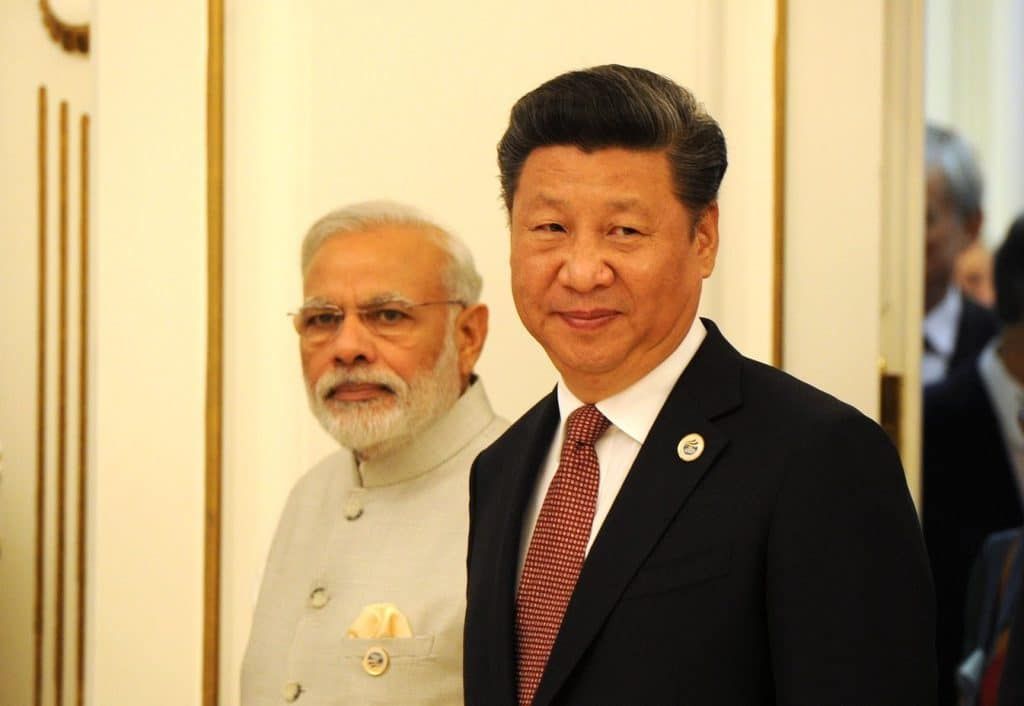India–China border dispute: the curious incident of a nuclear dog that didn’t bark
By Ramesh Thakur, Manpreet Sethi | September 7, 2020
 Narendra Modi and Xi Jinping, June 2016. Image credit: Wikimedia Commons.
Narendra Modi and Xi Jinping, June 2016. Image credit: Wikimedia Commons.
On June 15, nuclear-armed China and India fought with fists, rocks, and clubs along the world’s longest un-demarcated and contested boundary. Twenty Indian soldiers were killed; Indian estimates put the Chinese dead at around 40. The two countries remain in a state of military standoff.
Like the case of the dog that didn’t bark, which interested the great fictional detective Sherlock Holmes, the nuclear dimension of the recent border clashes was conspicuous by its invisibility. This may be in part because of the nuclear no-first-use policy expressed in the official nuclear doctrines of both countries. At a time when geopolitical tensions are high in several potential nuclear theaters, the nuclear arms control architecture is crumbling, and a new nuclear arms race is revving, there is a critical need to look for ideas that can prevent potential crises from escalating. Other nuclear powers can learn from China’s and India’s nuclear policies.
The normalization of nuclear threats. Over the last few years, leaders of many of the nuclear weapons states have taken to nuclear bluster. After the outbreak of the Ukraine crisis and annexation of Crimea in 2014, facing hostile Western criticism, Russian President Vladimir Putin pointedly remarked, “Russia is one of the most powerful nuclear nations”—a subtle but clear nuclear warning to the West. In July 2016, asked in Parliament if she would be prepared to authorize a nuclear strike that could kill 100,000 people, British Prime Minister Theresa May unwaveringly answered, “Yes.” And who can forget the tit-for-tat exchange of belligerent rhetoric by US President Donald Trump and North Korean leader Kim Jong-un in 2017 before the blossoming of their bromance in 2018?
In February 2019, after an attack on Indian paramilitary forces at Pulwama led to a clash between the air forces of India and Pakistan, Pakistan’s Prime Minister Imran Khan warned of the possibility of a nuclear war. Indian Prime Minister Narendra Modi, caught in the heat of an election campaign, responded that India’s nukes were not reserved for celebrating the fireworks festival of Diwali. After India revoked Kashmir’s autonomous status that August, Khan reiterated that nuclear war was a real risk. His foreign minister repeated the warning in Geneva later that same year.
This rhetoric, besides being dangerous, has given rise to another problem. The more the leaders of the nuclear armed states revalidate the role of nuclear weapons in their national security, the more they embolden calls of nuclear weapons acquisition in other countries like Germany, Japan, South Korea and Australia.
China and India’s nuclear reticence. This is where China and India, in the midst of a military crisis, provide a striking contrast. Neither side has drawn attention to its nuclear weapons in the 2020 border clashes. Nor have many analysts across the globe expressed alarm that the prolonged state of disquiet between the two could spiral out of control into a nuclear exchange. Southern Asia watchers are used to the nuclear shrillness that emanates from Pakistan every time a crisis breaks out after an act of cross-border terrorism or a skirmish. Against the India–Pakistan backdrop, the nuclear reticence of India and China is intriguing.
The lack of nuclear noise between the two could be a result of several different factors. For example, India has framed the role of its nuclear weapons for the narrow purpose of deterrence. So, even in the current crisis, it seeks to rely on a range of responses along the diplomatic, information, military, and economic spectrum rather than escalate to nuclear signaling.
China, meanwhile, does not view India as a threat, is dismissive of India’s great power pretensions, holds India’s possession of nuclear weapons to be illegitimate, and expects its own military-nuclear power advantage to grow rather than shrink in the future. Consequently, Indian actions are below China’s radar and do not affect its strategic choices.
But Chinese behavior does drive India’s nuclear policy. Toby Dalton and Tong Zhao, both experts on nuclear policy at the Carnegie Endowment for International Peace, describe this phenomenon as “decoupled deterrence,” where “only the smaller or weaker power takes security-seeking steps in response to actions by the bigger power, which are motivated by a different threat.” The flip side of this is that “China’s nuclear weapons are not directed at India.”
China, India, and no first use. An important dimension, however, that has been underestimated in explaining the two countries’ apparent nuclear sobriety is the similarity in their approach to nuclear weapons and deterrence.
They are the only two of the nine nuclear armed states with the stated commitment to a no-first-use policy, and the force postures to match. Both countries envisage the role of nuclear weapons primarily as a political one, not a military one. Accordingly, in the declared nuclear doctrines of both, the arsenal is meant for safeguarding the nation against nuclear blackmail and coercion, and neither supports the idea of war-fighting with nuclear weapons. While they face different threats, and China doesn’t even accept India as a nuclear armed state, the similarity of their nuclear philosophy brings a sense of strategic stability between the two.
China’s no-first-use policy is a logical corollary of its concept of “limited deterrence.” In a 2019 defense white paper, a document considered to be an authoritative statement of official doctrine, the Chinese government reiterated that it will never be the first to use, or threaten to use, nuclear weapons against anyone “under any circumstances.” Its operational plans do not call for the first use of nuclear weapons, nor even the threat of first use, and, as a safeguard against inadvertent or unauthorized use, the military keeps warheads off-alert and stored separately from delivery systems in peacetime.
India maintains a similar posture. The core elements of India’s nuclear doctrine, articulated in a draft in 1999, include a credible minimum deterrent and unilateral promises of no use of nuclear weapons against non-nuclear weapon states, and no first use against nuclear adversaries. These attributes have since been proclaimed in the official doctrine put out as a Press Note from the Cabinet Committee on Security in 2003. They allow the armed forces to keep the arsenal in a relaxed state.
Will China and India abandon no first use? However, the ability of both countries to maintain this posture does not rest solely on domestic considerations. The perceived threat environment casts a long shadow on the future of their nuclear policies. Changes in US nuclear doctrine that may favor the idea of limited nuclear war and the concomitant build-up of requisite nuclear capabilities, including ballistic missile defenses, has caused concern in China about the survivability of its arsenal, and hence the credibility of its nuclear deterrent. If this trend intensifies, China’s no-first-use pledge could come under pressure.
In the case of India, too, a debate on the viability of no first use continues in some strategic circles among retired military men, diplomats, and analysts. On August 16, 2019, Defense Minister Rajnath Singh added grist to the mill through a statement that was interpreted as casting doubt on India’s commitment to no first use. He was speaking days after India had annulled Kashmir’s special status, which had in turn provoked a flurry of apocalyptic warnings from Pakistan, a country whose leaders have no qualms talking about nuclear first use.
The defense minister’s statement notwithstanding, much of the speculation about a change in India’s posture may be unfounded, as it rests on a fallacious interpretation of the politics of India’s no-first-use policy. Singh was speaking on the one-year anniversary of the death of Atal Bihari Vajpayee, the Indian prime minister who had authorized the 1998 tests, and at the site of those tests. Moreover, the substance of what he said, as distinct from whether it was wise to say it, was a banal homily: while no-first-use was present policy, “what happens in future depends on the circumstances.” He did not claim that he had asked for an internal review of the doctrine.
The benefits of a no-first-use posture. The prospect of the United States adopting a no-first-use policy along the lines of that of India and China arouses skepticism in the strategic community. Some believe that, at best, it would be viewed by other countries as an empty gesture. And, at worst, it could increase the risk of war by weakening deterrence. No doubt Christopher Ford, the Trump administration’s top ranking arms control official, would include no first use among the undesirable policies of a “nuclear identity politics” that, in his words, is based on little more than “virtue signaling, progressive solidarity, and consciousness-raising” by the ideologically driven arms control community.
Yet, a no-first-use policy could have significant practical implications. It would encourage a shift away from high-risk doctrines that require keeping nuclear weapons on high alert, ready to fire at a moment’s notice. Taking the weapons off high alert, and separating warheads from the missiles that deliver them, are natural parts of a no-first-use doctrine and would significantly lower the prospects of accidental or unauthorized use.
A no-first-use policy could also allow for greater response time, so that officials can cross-check and verify incoming threat information. This would be of even greater relevance as the advent of new technologies such as hypersonic delivery vehicles and the use of artificial intelligence in nuclear command and control compresses decision making timelines.
Finally, a no-first-use policy would help keep a lid on leaders who are prone to spouting dangerous nuclear bluster. In particular, if the United States adopted no first use, there may be salutary effects to deemphasizing the role of nuclear weapons in national security that may trickle down to other nuclear possessors. Reducing the salience of weapons in national security strategies will also help address the problem of mounting nuclear risks.
In 2014, China and India called for negotiations on a no-first-use convention among the world’s nuclear powers. It might be time for the United States and other countries to give it a serious look. Indeed, the China–India border standoff demonstrates the practical utility of a nuclear policy centered on no-first-use and merits wider international attention.
Together, we make the world safer.
The Bulletin elevates expert voices above the noise. But as an independent nonprofit organization, our operations depend on the support of readers like you. Help us continue to deliver quality journalism that holds leaders accountable. Your support of our work at any level is important. In return, we promise our coverage will be understandable, influential, vigilant, solution-oriented, and fair-minded. Together we can make a difference.
Keywords: China, India, border dispute, no first use
Topics: Nuclear Weapons
















